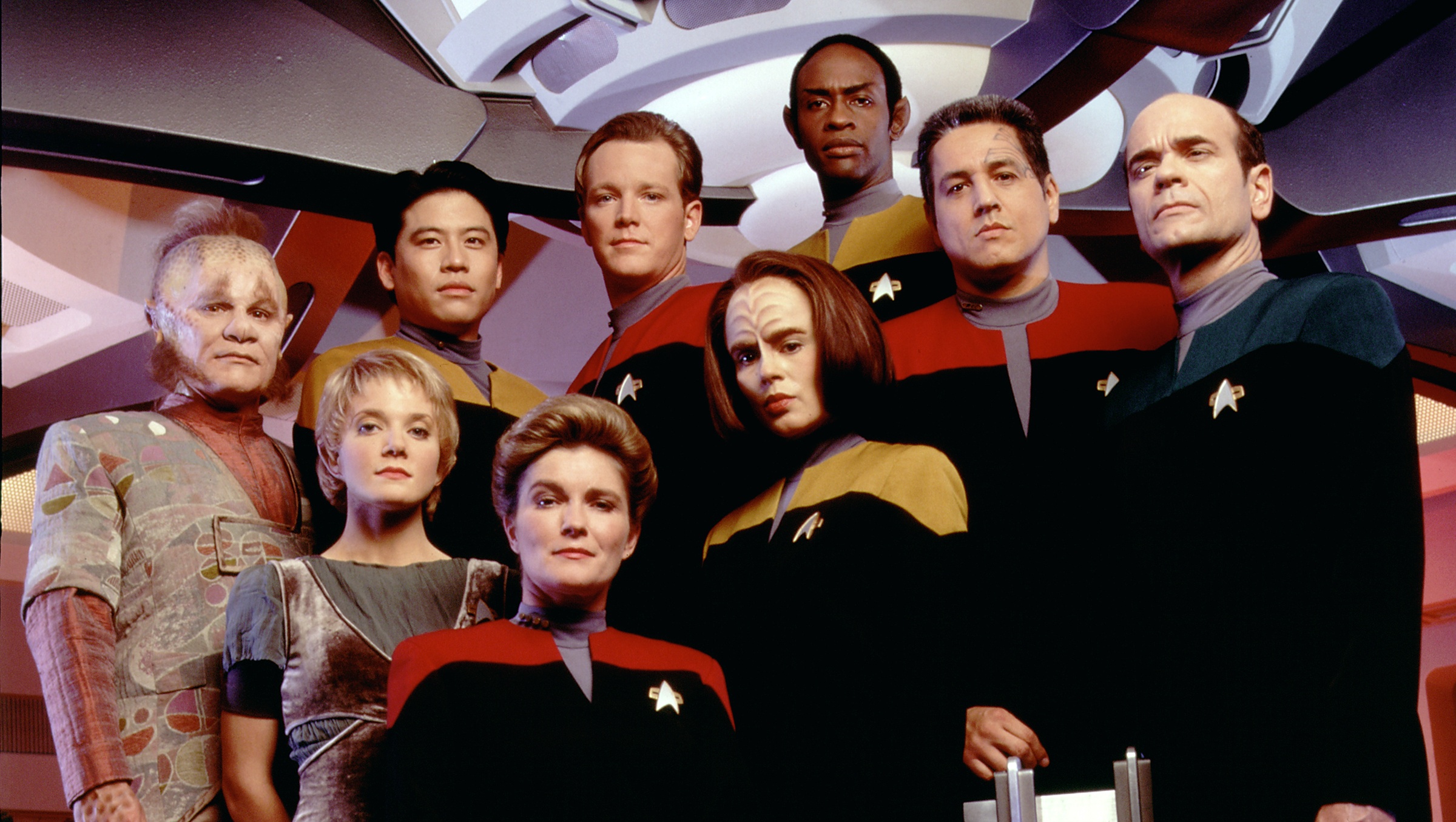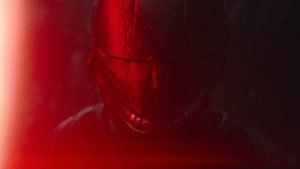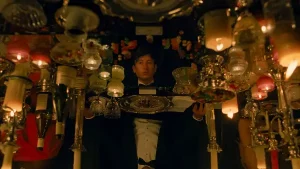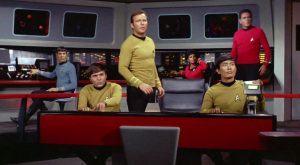
Here lies Thomas Eugene Paris, beloved mutant. That’s what Trekkies think about every Jan. 29, known among some as “Threshold Day,” commemorating the 1996 airing of the Star Trek: Voyager season two episode “Threshold.” Threshold Day consists mostly of memes and jokes, poking fun at what most consider one of the series’ worst episodes, if not one of the most embarrassing Star Trek episodes of all time.
While it is certainly corny, “Threshold” doesn’t quite deserve its ignoble reputation. Not only is it far from the worst episode of Voyager (Chakotay’s ancestors’ bones play no part in the story), but it contains a lot of qualities found in the best Star Trek episodes. Is that enough to elevate “Threshold” to the upper Trek tiers? No, but it is enough to give the episode a better reputation than the one it has now.
Crossing the Threshold
Directed by TV veteran Alexander Singer, from a teleplay written by Voyager producer Brannon Braga and based on a story by Michael De Luca (the man who wrote John Carpenter‘s In the Mouth of Madness and currently serves as co-chairperson of Warner Bros. Motion Picture Group), the second season episode “Threshold” involves Tom Paris’s attempts to cross the warp threshold. Paris achieves this goal, reaching Warp 10 in a runabout, but achievement is undercut when his body begins changing and he mutates into a lizard-looking creature. In this form, Paris kidnaps Captain Janeway and puts her in the runabout, traveling to Warp 10 with her. When Chakotay and Tuvok find Paris and Janeway, they’ve changed into giant salamanders and mated.
Yes, that’s an episode with a strange premise, one of many in Voyager‘s first few seasons. Most Trek series take a couple of seasons to find their footing, as when the crew develop a camaraderie in The Next Generation, the Dominion reveals itself as a threat in Deep Space Nine, or the titular ship jumps ahead 900 years in Discovery.
In Voyager, these problems stemmed from failures in the very premise of the show. No one holds Janeway responsible for unilaterally stranding the Voyager in the Delta Quadrant, there’s no tension between the Starfleet regulars and members of the renegade group the Maquis, and Neelix is creepy and controlling until Kes leaves in season four.
To be sure, some of these problems do occur in “Threshold.” After the credits, the episode finds Neelix inserting himself into a conversation between Kim, Paris, and Torres. Sure, Neelix’s comments do spark the brainstorm that ends with a solution, but the sitcom joke structure grates even today. Furthermore, Tom mentions his former Maquis status during a terrified rant, something that Janeway dismisses just like everyone else ignores the Maquis’ past crimes against Starfleet.
And yet, despite these shortcomings, “Threshold” still successfully checks off a few important Trek boxes.
In the Zephram Cochrane Tradition
“Threshold” begins with a classic Trek problem. Tom Paris wants to cross the warp threshold to test the limits of his spacecraft. He does so in a runabout called the Cochrane, named for Zephram Cochrane, the first human to create a warp drive. When his simulations hit problems, Paris consults Kim and Torres, and the trio brainstorms ideas. Once they come up with an idea and successfully run it through a simulation, they pitch the idea to Janeway, who approves a manned experiment. In other words, the team has an aspiration, uses collaboration and the scientific method to address a problem, and adheres to the chain of command. “Threshold” begins as an example of Starfleet at its best.
Detractors might point to the various mistakes made along the way, most notably when Paris talks Janeway out of letting Kim take the test flight, a command decision she first makes because of a rare and largely untroubling medical condition. However, Tom’s refusal to be bound to his physical limits are nothing new to Star Trek. Kirk said the same thing when Starfleet told him that he was too old, Picard said the same thing when his artificial heart became an issue. Going beyond limits is part of Starfleet’s ethos.
Like Zephram Cochrane himself, Tom overcomes the obstacles to do something that most would consider foolish and reckless, relying on his intelligence, reason, and fellow explorers to go on some kind of star trek.
Boldly Going Gone Badly
As much as Trek values aspiration and scientific pursuit, it also understands the dangers of unchecked hubris, which leads to the other part of the episode. Words cannot properly explain Tom’s transformation, which director Singer lets occupy the middle section of the episode. Ghastly effects by Michael Westmore, who won a Primetime Emmy for “Threshold,” see Paris lose his distinguishing features, changing into a goopy monster with webbed feet and an indistinct face.
Mutant Tom draws heavily from Universal horror tropes, not just when he carries away Janeway in the manner of a creature dragging away a damsel on an old one-sheet. As Tom faces death, he becomes honest in his fears and desires, asking Kes for a kiss while also ranting about his anger at his father. The scene in which Tom lashes out at Janeway and then immediately apologizes and begs her to stay captures his vulnerable state, as if he’s clutching at every last thing that makes him human. But it fails, and he becomes a monster.
That failure and the price that Paris pays has always been part of the Trek adventure. Every time Kirk and the crew had to pull out their phasers or face down a god-like being, they experienced the consequences of exploration. Most Star Trek: Enterprise episodes dealt with the various compromises made by the fledging Starfleet as it gets to know the wider universe. Both Deep Space Nine and Discovery dealt with the redefinition of Federation values in extreme circumstances. TNG is bookended with Q testing humanity’s ability to handle the complex situations they encounter, a test that continues with the finale of Picard.
Tom’s grotesque mutation shows the stakes of the test. He put his intellect, and his hubris, in service of pushing humanity forward, and he paid the price by losing that humanity. The Doctor manages to revert he and Janeway to their human form, which suggests that his achievement has been undone, but the episode ends with Tom earning a commendation and, most notably, he and Janeway’s salamander babies are still out there.
Silly Trek is Not Stupid Trek
Is “Threshold” silly? Absolutely. The very fact that Tom and Janeway have salamander kids is bizarre, especially since no one has mentioned it since (except Lower Decks, of course. Lower Decks never forgets).
But ever since Spock smiled at giggling flowers in “The Cage,” silliness has been the cost of exploration on Star Trek. Going forward often involves crossing boundaries, even if it’s stepping over the threshold into goofiness.
The post The So-Called Worst Star Trek: Voyager Episode Is A Lot Better Than You Think appeared first on Den of Geek.






